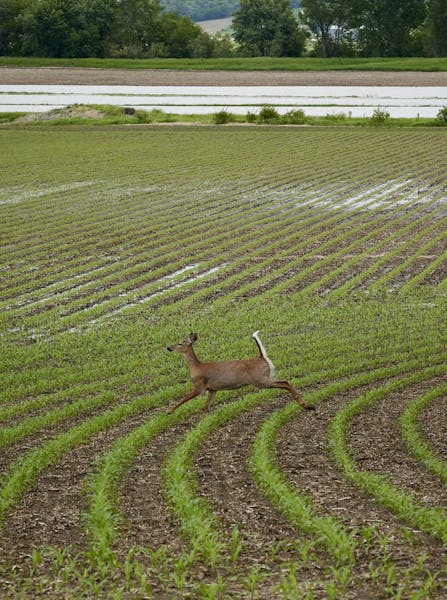A hailstorm that ripped through southwest Minnesota last week left thousands of acres of corn and soybeans damaged or destroyed — in many cases too late in the season for farmers to replant their crops.
"We had a corn and bean field down to dirt again," said George Sill, a farmer southwest of Madelia. "You couldn't hardly tell it had been planted there."
Sill said 150 acres of soybeans and 90 acres of corn were leveled by the storm, and another 200 acres of crops damaged to varying degrees.
When he drove out to his fields after the storm, hailstones were drifted up by the road and fog was rolling in off the fields because so much ice was melting all at once.
"There's multiple veins of hail that ran from the Sleepy Eye area down to St. James and maybe even further south," said Steve Michels, an agronomist at Crystal Valley, a cooperative with a location in La Salle. "It's not unusual to have a hailstorm, but this was one of the more severe ones I've seen."
The bands of hail were 2 to 3 miles wide and tapered off quickly. About a quarter of all the farmers Michels works with were affected — dozens of farmers but fewer than 100, he said.
One farmer told Michels that golf ball-sized hail fell for 20 minutes.
"He showed me some trees where the hail took the bark off the trees," Michels said.
Three tornadoes touched down in the storm, which hit on June 20, but no injuries were reported.
For cornfields that were destroyed, it's too late to replant. Soybeans can be replanted until about the first week of July, but another round of rain Thursday will keep farmers out of the fields a few more days, Michels said.
The University of Minnesota Extension said fields should only be replanted if they are a total loss, and soybeans planted in late June suffer something like a 40% yield reduction compared to soybeans planted in May.
Sill, the farmer near Madelia, said he has crop-hail insurance. He thinks most of his corn will grow back since the "growing point" is near ground level and corn is hardy. The soybeans will have to be replanted.
"It's been a long enough planting season already and now I gotta go back and plant another 150 acres of beans," he said.
Corn and soybean prices have rallied in the past 45 days with projections of a weaker harvest across the U.S. All eyes will be on the U.S. Department of Agriculture's annual Acreage Report, due to be published at noon Friday.
Adam Belz • 612-673-4405 Twitter: @adambelz

After a bumper crop of new sales taxes approved in 2023, legislators eye limits

Minnesota plan to close state addiction treatment facilities faces pushback

Why you should donate clothing: It (probably) won't end up at the dump
4 are now charged in inside job armed robbery of Hopkins grocery store that netted $45K

